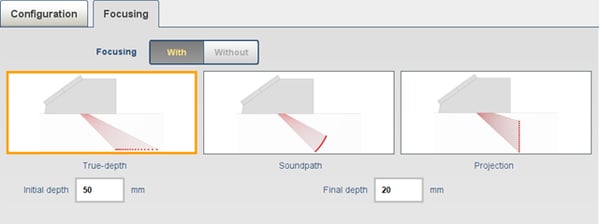Delay laws are in essence what the phased array technique is all about. We can electronically scan, steer, and focus energy by adapting the time delay for each element. Let's focus today (no pun intended) on focalization.
Focalization, as its name implies, focuses the energy on a small spot. This improves the lateral resolution, thus the ability to dissociate two close indications. It also improves the Signal-to-Noise Ratio (SNR) by sending more energy to the indications.
However, it is important to focus the energy at the right spot. To help operators deal with most situations, the M2M Gekko® offers three focusing options on the equipment, eliminating the need to calculate using external software and/or import the delay laws:
- Depth focusing
- Constant soundpath focusing
- Constant projection focusing

Depth focusing is the most well known and typically used method on most phased array equipment. The operator simply specifies the depth of the focalization points. We look here at the row of 1mm (0.04in) side-drilled holes (SDH) aligned at 10mm (0.39in) in the ASTM 2491 mockup.
Soundpath focusing: the Gekko focuses the energy at a constant soundpath. The ASTM 2491 mockup has two arrays of SDH on a 25mm (0.98in) and 50mm (1.97in) radii, respectively. The S-scans shows the results obtained with a soundpath focalization at 25mm (0.98in) and 50mm (1.97in). We can see the influence of focalization on the detection of the SDH. If the focal spots are not at the right depths, the SNR is relatively poor.
Projection focusing: the operator specifies the distance from a reference point and the angle of the focalization spots. We look here at the angled row and the vertical column of SDH in the ASTM mockup. This allows perfect focalization along any line inside the components such as the chamfer of welds.
All these delay laws are available for linear, matrix, dual linear array (DLA), and dual matrix array (DMA) probes, allowing inspectors to optimize and adjust the focalization parameters on the job. And, of course, you can use up to 64 elements at the same time to improve both the lateral resolution and SNR.
Did you know that we offer phased array UT probes and wedges in our online shop? Check it out here! For more information on the helpful features offered by the Gekko, contact our NDT experts and stay Beyond Current.



